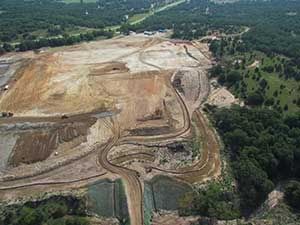Frack sand mining doesn't just suck, it blows
Daily Kos, June 22, 2011
When they say fracking goes miles deep and miles wide, they aren’t kidding. Where do you think the fracking sand comes from?

Recently I learned that EOG, aka Enron Oil and Gas, is planning to start a frack sand mining and processing plant in Cooke County near the beautiful Saint Jo. The planned 1,400-acre facility will handle all stages of production and transportation. Although EOG has only applied for and has not yet been granted the permit by TCEQ, they have already done a lot of construction and water well drilling at the proposed site. You can see aerial photographs acquired through the efforts of local citizens at the Save The Trinity Aquifer blog spot.
Frack sand mining sucks!
This facility will use 3,700 gallons of water per minute, 24 hours per day, 7 days per week, year round and we do not know the longevity of the mine other than the “permanent” box was checked on the permit application.
To put that water use into perspective: according to the US Geological Survey, the average person uses 80 to 100 gallons of water per day. So EOG will use more water in one minute than you use in a month. They will use 1,944,720,000 gallons of water a year, which is enough water for 53,280 people for a year.
EOG has already drilled 10 water wells, 7 of which were dry and the shallowest was 600'. That means they are drilling into the Trinity Aquifer. They plan to drill 40 water wells to meet their water needs. In order to avoid regulation by the Upper Trinity Groundwater Conservation District, EOG moved the facility across the Montague County line to the Cooke County side. The Cooke GCD will be in place on January 1st so EOG is hustling to get their water wells completed before that date.
An unspecified amount of water will be recycled but it's important to note this recycled water will not be returned to the aquifer.
Mountain Creek runs right by the facility (see photos) and only a short distance away, flows into the Red River. At that point, is a major spawning area for striped bass.
Frack sand mining blows!
The TCEQ air permit from starts with the sand mine processing and does not take the impacts from mining into consideration. It starts when the sand is wet so we do not have any idea about the air impacts from mining the sand and processing it before it is wet.
Impacts on the permit include:
NOx 26.3 tpy
Carbon Monoxide 13.7 tpy
VOCs .876 tpy
Sulfur Dioxide 2.32 tpy
Particulate Matter (PM) (total) 34.7 tpy
PM (10 microns) 29.9 tpy
PM (2.5 microns) 27.9 tpy
Carbon Monoxide 13.7 tpy
VOCs .876 tpy
Sulfur Dioxide 2.32 tpy
Particulate Matter (PM) (total) 34.7 tpy
PM (10 microns) 29.9 tpy
PM (2.5 microns) 27.9 tpy
It blows so hard in Montague County that Denton gets 40% of their energy from the wind farm there. The silica sand can blow and create impacts 20 miles away. Breathing silica sand is a health hazard. According to Halliburton’s MSDS sheet, breathing silica sand can cause lung cancer.
Oil and gas extraction and particularly EOG has been hard on Montague County. Last year the industry used almost 91% of the water used in Montague County. EOG’s practice of burying reserve/waste pits in Montague County has already tainted water.
For more information, see the following:
This was originally posted on EARTHblog for EARTHWORKS' Oil and Gas Accountability Project.







No comments:
Post a Comment